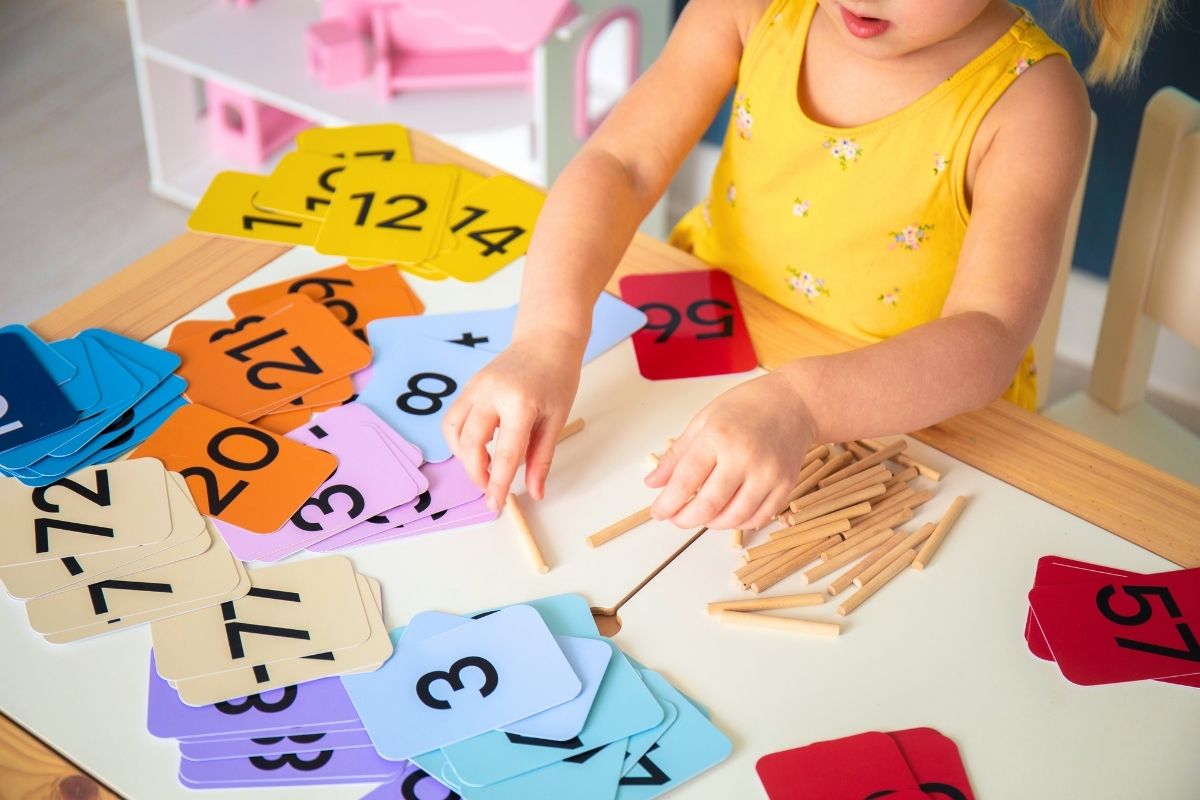Montessori math materials are meticulously crafted to ignite curiosity and foster a deep understanding of mathematical concepts. Whether it’s the tactile allure of the bead stair or the logical challenge posed by the checkerboard, each material is designed for specific age groups, ensuring age-appropriate and effective learning. This guide will walk you through the best Montessori math materials tailored for each developmental stage, seamlessly guiding young minds from basic counting to complex arithmetic.
Montessori’s Concrete to Abstract Math Approach
Montessori math is a unique approach to teaching mathematics that emphasizes hands-on, tactile learning. Rooted in the Montessori philosophy, this method introduces children to mathematical concepts using specially designed arithmetic and math materials that cater to their innate curiosity and developmental needs.
These materials play a pivotal role in operations like multiplication and division. For instance, the Golden Beads offer a concrete representation of numbers, allowing children to physically see and manipulate units, tens, hundreds, and thousands. As they engage with these arithmetic materials, children transition from performing tangible multiplication using the beads to more abstract methods.
The progression of Montessori math materials is thoughtfully structured, ensuring that as children delve deeper into concepts like division and multiplication, they not only learn the operations but also deeply comprehend the logic and reasoning behind them.
Benefits of Montessori Math
- Holistic Development: Montessori math not only focuses on arithmetic but also nurtures problem-solving skills, critical thinking, and logical reasoning in children.
- Self-paced Learning: The approach respects individual learning speeds, allowing kids to progress at their own pace, ensuring a deep understanding of concepts.
- Boosts Confidence: The hands-on nature of Montessori materials empowers children, giving them the confidence to tackle complex problems independently.
- Fosters a Love for Math: By making math tangible and relatable, Montessori diminishes math anxiety and cultivates a genuine interest in the subject among toddlers.
- Prepares for Real-world Challenges: The practical nature of Montessori math prepares children for real-world applications, bridging the gap between theoretical knowledge and practical application.
Best Montessori Math Materials
Selecting the best Montessori math material tailored to every age is crucial for fostering a child’s love for mathematics. Each age-specific math material plays a pivotal role in their learning journey, ensuring a seamless transition from one stage to the next.
Best Montessori Math Materials 0 – 3 Years Old (Kindergarten)
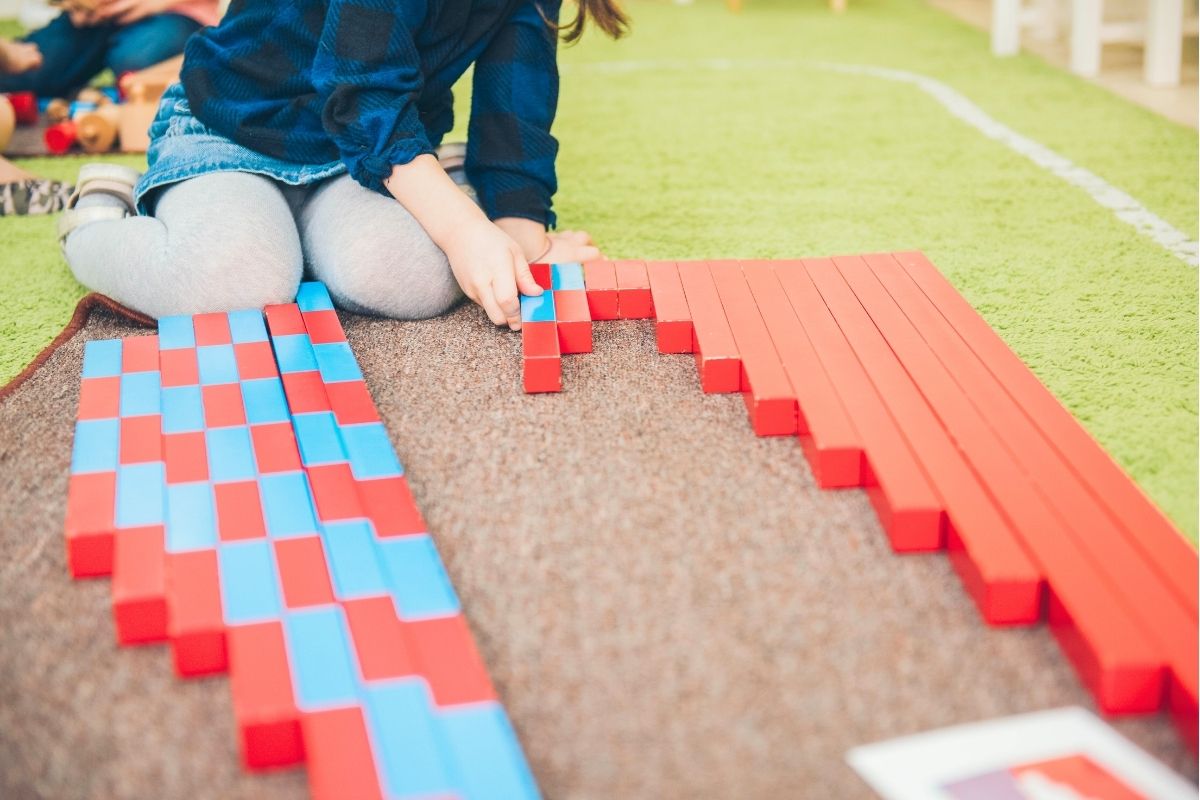
During these formative years, the focus is on cultivating a child’s innate curiosity and laying the foundation for mathematical understanding. The materials introduce basic concepts such as counting, size differentiation, and number recognition. The purpose is to develop a child’s sensory and motor skills while instilling a preliminary understanding of quantities and their representations.
| Math Material | Description | Purpose |
|---|---|---|
| Bead Stair | A set of colored beads, each representing numbers from 1 to 9. | Counting and number recognition |
| Bead Stringing | Activities involving stringing beads. | Early counting and fine motor skill development |
| Counting Beads | Simple beads for toddlers to practice counting. | Basic counting and number recognition |
| Counting Frames | Frames with beads that help introduce toddlers to numbers. | Introduction to numbers and quantities |
| Knobless Cylinders | Sets of cylinders of varying sizes. | Size differentiation |
| Number Puzzles | Wooden puzzles that introduce toddlers to numbers. | Tactile introduction to numbers |
| Number Rods | Wooden rods of varying lengths that visually represent numbers. | Quantity and number association |
| Sandpaper Numbers | Numbers made from sandpaper on cards. | Tactile number recognition |
| Spindle Boxes | Boxes with compartments and spindles. | Associating quantities with number symbols |
Best Montessori Math Materials 3 – 6 Years Old (Preschool)
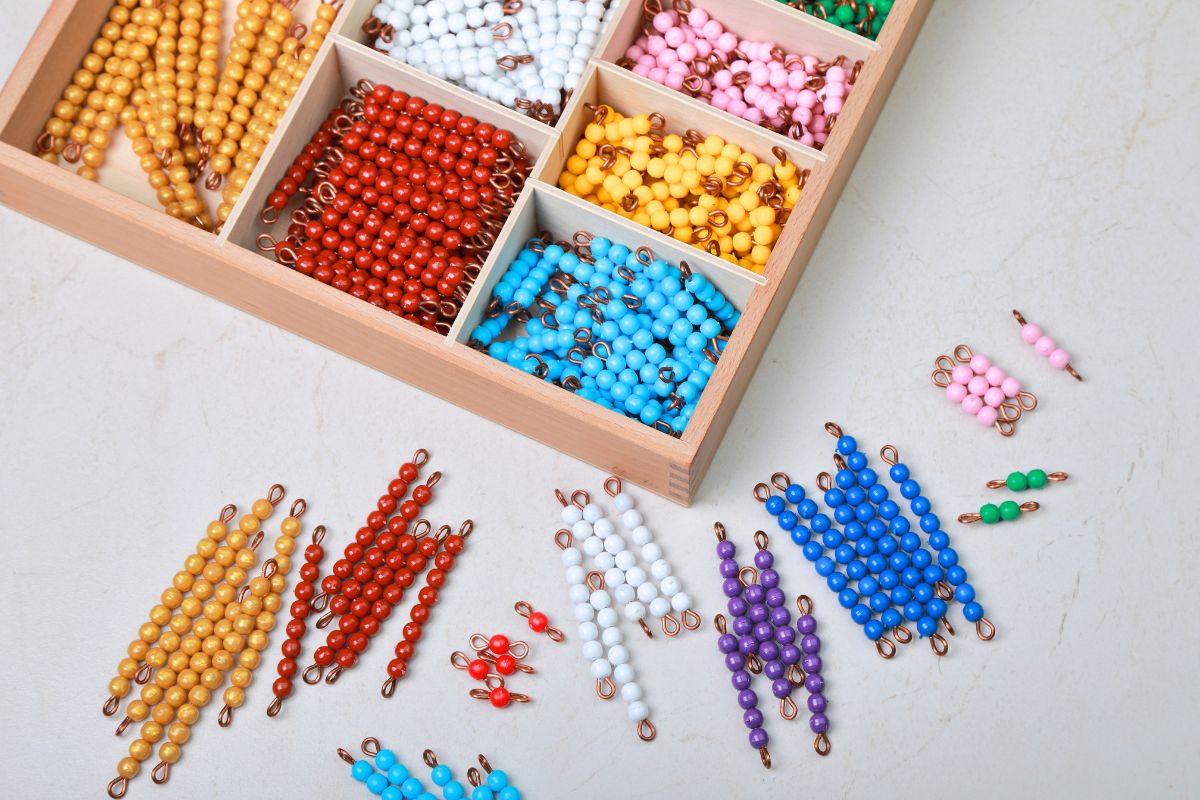
In this phase, children delve deeper into the world of mathematics, transitioning from concrete to abstract thinking. The materials are designed to foster a deeper understanding of numbers, arithmetic operations, and the basics of the decimal system. The aim is to nurture a child’s analytical skills, promote logical reasoning, and establish a solid foundation for more advanced mathematical concepts.
| Math Material | Description | Purspose |
|---|---|---|
| Abacus | A counting frame used to teach basic arithmetic operations. | Basic arithmetic, counting, and number representation. |
| Addition Snake Game | Bead bars used for hands-on practice of addition. | Interactive addition |
| Addition Strip Board | A board with strips for practicing addition. | Visual addition guidance |
| Bead Bars | Colored bead bars that visually represent numbers. | Basic arithmetic operations |
| Bead Cabinet | Contains chains and beads for counting. | Counting, squaring, and cubing |
| Bead Chains | Chains of colored beads for counting. | Linear and skip counting |
| Bead Stair (Short Bead Stair) | Colored beads representing numbers 1 to 9. | Deepened understanding of counting |
| Clock for Time Telling | Model clock to teach children time. | Reading and understanding time |
| Colored Bead Stairs | Sets of colored beads for counting. | Recognizing and counting numbers |
| Currency Materials | Tools representing currency denominations. | Introduction to money |
| Division Board | A board designed for hands-on division practice. | Interactive division practice |
| Dot Game | Board with colored dots for counting. | Visual addition practice |
| Fraction Circles | Circular pieces divided into fractions. | Representing parts of a whole |
| Geometric Cabinet | Cabinet with geometric shapes. | Shape recognition |
| Golden Beads | Beads representing units to thousands. | Introduction to the decimal system |
| Hundred Board | Board with tiles numbered 1-100. | Number sequencing and recognition |
| Large Number Cards | Cards with large numbers. | Recognizing numbers and understanding place value |
| Multiplication Boards | Boards designed for multiplication | Hands-on multiplication |
| Snake Game | Bead bars used for hands-on addition. | Hands-on addition practice |
| Stamp Game | Colored number tiles for arithmetic. | Arithmetic practice |
| Strip Boards | Boards for addition and subtraction. | Hands-on addition and subtraction |
| Subtraction Snake Game | Bead bars used for hands-on practice of subtraction. | Interactive subtraction |
| Subtraction Strip Board | A board with strips for practicing subtraction. | Visual subtraction guidance |
| Tens and Teens Boards (Seguin Boards) | Boards for numbers 10-19. | Understanding the concept of tens |
Best Montessori Math Materials 6 – 9 Years Old (Elementary School)
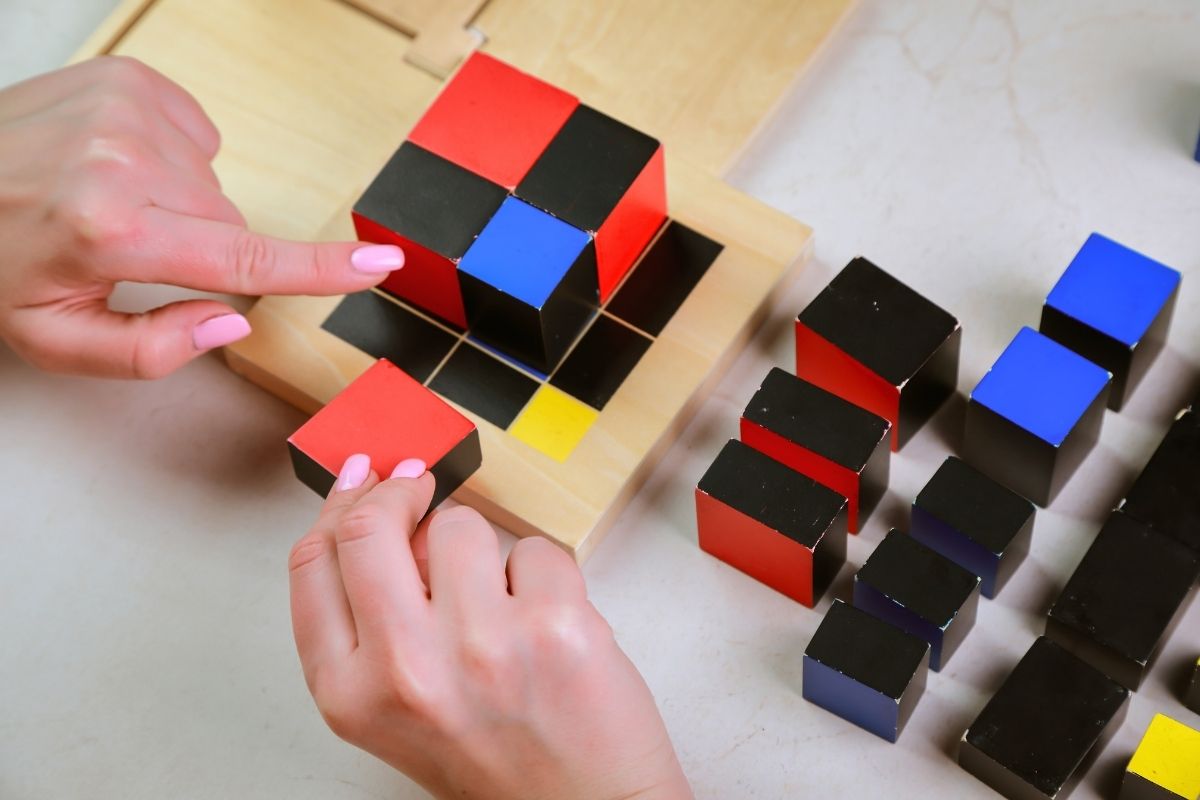
As children enter the elementary years, they are introduced to more complex mathematical operations and concepts. The materials expand on their prior knowledge, introducing them to topics like multiplication, division, fractions, and geometry. The purpose is to equip children with the skills and understanding necessary to tackle advanced mathematical challenges, fostering independent thinking and problem-solving abilities.
| Math Material | Description | Purpose |
|---|---|---|
| Advanced Bead Frame | A tool for performing arithmetic operations using beads. | Addition, subtraction, multiplication, and division |
| Bead Decanomial | A set of bead bars representing multiplication tables visually. | Visual multiplication tables |
| Binomial Cube | Three-dimensional puzzle representing the (a+b)² formula. | Algebraic equations |
| Checkerboard | Hands-on material for practicing multiplication. | Multiplication with multi-digit numbers |
| Constructive Triangles | Triangles that can be combined to form different polygons. | Geometry |
| Cube and Square Root Board | Materials that visually represent the concepts of square and cube roots. | Square and cube roots |
| Decimal Fraction Materials | Tools that help children understand decimals and their relation to fractions. | Decimals and fractions |
| Division Racks and Tubes | Material designed for understanding long division. | Long division |
| Flat Bead Frame | Tool for performing arithmetic operations with larger numbers. | Arithmetic with larger numbers |
| Fraction Skittles | Tools that represent fractions tangibly. | Visualizing fractions |
| Geometric Solids | Three-dimensional shapes. | Geometry concepts |
| Geometric Stick Materials | Sticks of varying lengths and colors. | Lines, angles, and shapes |
| Hierarchical Material | Represents units to thousands. | Place value and the decimal system |
| Large Wooden Hierarchical Material | Wooden pieces representing the decimal system. | Understanding place value |
| Long Division Materials | Tools that provide a concrete representation of the long division process. | Long division |
| Negative Snake Game | Bead bars that introduce the concept of negative numbers. | Negative numbers and arithmetic |
| Peg Boards | Boards for exploring basic algebraic concepts and patterns. | Basic algebra and patterns |
| Protractor | A tool used to measure angles. | Angle measurement |
| Pythagoras Board | Board that visually demonstrates the Pythagorean theorem. | Pythagorean theorem |
| Small Bead Frame | Tool for addition and subtraction of larger numbers. | Addition and subtraction of larger numbers |
| Trinomial Cube | Three-dimensional puzzle representing the (a+b+c)³ formula. | Algebraic equations |
Montessori Math Material Complete List (A to Z)
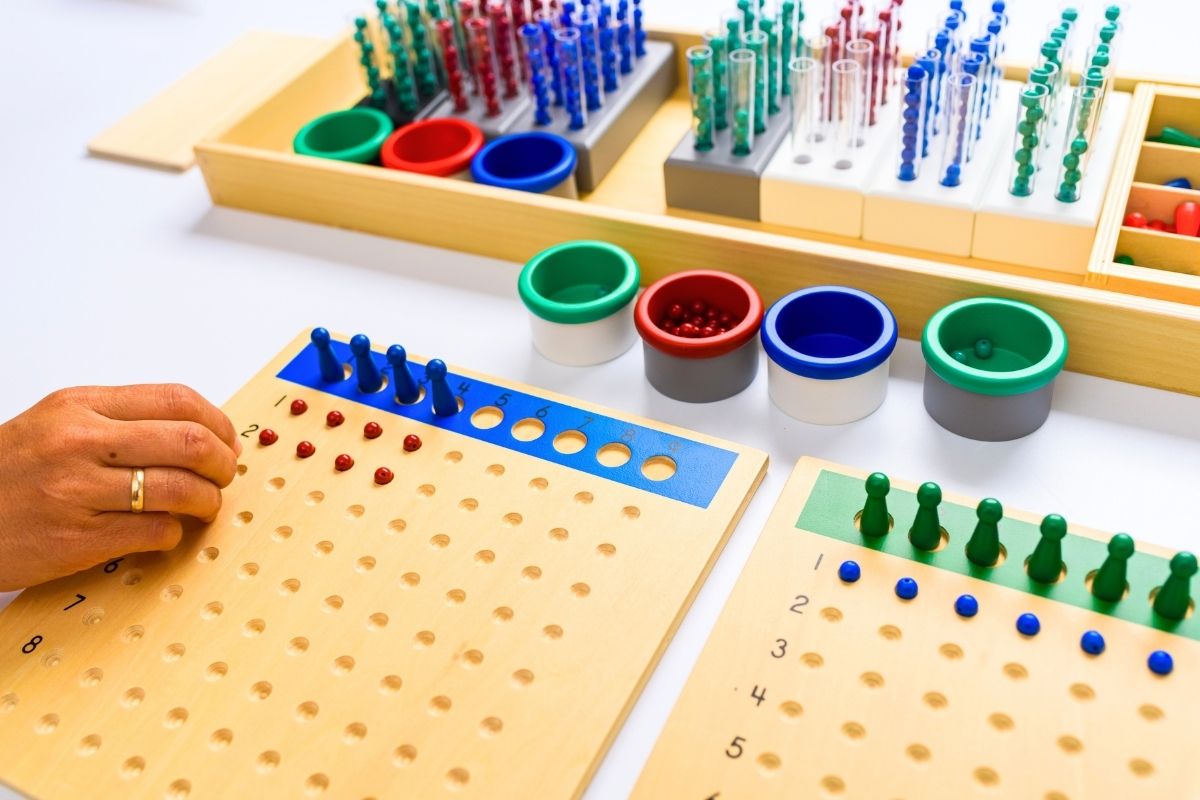
From basic math materials to more advanced once, explore the world of Montessori math and its hands-on approach to teaching mathematics.
| Material Name | Age | School Level | Purpose | Description |
|---|---|---|---|---|
| Abacus | 3-6 | Preschool | Basic Arithmetic Operations | A traditional counting tool with beads on rods, facilitating hands-on learning of addition, subtraction, multiplication, and division. |
| Addition Board | 3-6 | Preschool | Basic Addition | A board designed to facilitate addition exercises. |
| Addition Snake Game | 3-6 | Preschool | Interactive Addition | Bead bars designed for interactive addition exercises. |
| Advanced Bead Frame | 6-9 | Elementary | Arithmetic Operations | Tool for arithmetic operations using beads. |
| Bead Bars | 3-6 | Preschool | Basic Arithmetic Operations | Colored bead bars that visually represent numbers. |
| Bead Cabinet | 3-6 | Preschool | Counting, Squaring, & Cubing | Contains chains and beads for counting. |
| Bead Chains | 3-6 | Preschool | Linear & Skip Counting | Chains of colored beads for counting. |
| Bead Decanomial | 6-9 | Elementary | Visual Multiplication Tables | Bead bars representing multiplication tables. |
| Bead Stair (Short Bead Stair) | 0-3 | Kindergarten | Counting & Number Recognition | Colored beads representing numbers 1 to 9. |
| Bead Stringing | 0-3 | Kindergarten | Fine Motor Skills & Early Counting | Activities involving stringing beads. |
| Binomial Cube | 3-6 | Preschool | Algebraic Equations | A three-dimensional puzzle representing the binomial equation. |
| Checkerboard | 6-9 | Elementary | Multi-digit Multiplication | Hands-on material for multiplication. |
| Clock for Time Telling | 3-6 | Preschool | Time Reading | Model clock to teach children time. |
| Constructive Triangles | 6-9 | Elementary | Geometry | Triangles combined to form polygons. |
| Counting Beads | 0-3 | Kindergarten | Basic Counting | Simple beads for practicing basic counting. |
| Counting Frames | 0-3 | Kindergarten | Introduction to Numbers | Frames with beads that introduce the concept of numbers and quantities. |
| Decimal Fraction Materials | 6-9 | Elementary | Decimals & Fractions | Tools to understand decimals and their relation to fractions. |
| Division Board | 3-6 | Preschool | Interactive Division | A board equipped with sets and layouts to facilitate division exercises. |
| Division Racks and Tubes | 6-9 | Elementary | Long Division | Material for understanding long division. |
| Dot Game | 3-6 | Preschool | Visual Addition Practice | Board with colored dots for counting. |
| Flat Bead Frame | 6-9 | Elementary | Arithmetic with Larger Numbers | Tool for arithmetic with larger numbers. |
| Fraction Skittles | 6-9 | Elementary | Visualizing Fractions | Tools that represent fractions tangibly. |
| Geometric Cabinet | 3-6 | Preschool | Shape Recognition | Cabinet with geometric shapes. |
| Geometric Solids | 6-9 | Elementary | Geometry Concepts | Three-dimensional shapes. |
| Geometric Stick Materials | 6-9 | Elementary | Geometry Concepts | Sticks of varying lengths and colors. |
| Golden Beads | 3-6 | Preschool | Decimal System Introduction | Beads representing units to thousands. |
| Hierarchical Material | 6-9 | Elementary | Decimal System & Place Value | Represents units to thousands. |
| Hundred Board | 3-6 | Preschool | Number Sequencing | Board with tiles numbered 1-100. |
| Knobless Cylinders | 0-3 | Kindergarten | Size Differentiation | Sets of cylinders of varying sizes. |
| Large Number Cards | 3-6 | Preschool | Recognizing Numbers | Cards with large numbers. |
| Multiplication and Division Bead Boards | 3-6 | Preschool | Hands-on Multiplication & Division | Boards for multiplication and division. |
| Negative Snake Game | 6-9 | Elementary | Negative Numbers Arithmetic | Bead bars for negative numbers. |
| Number Puzzles | 0-3 | Kindergarten | Tactile Introduction to Numbers | Wooden puzzles that introduce numbers. |
| Number Rods | 0-3 | Kindergarten | Quantity & Number Association | Wooden rods of varying lengths that visually represent numbers. |
| Peg Boards | 6-9 | Elementary | Basic Algebra & Patterns | Boards for exploring algebraic concepts. |
| Protractor | 6-9 | Elementary | Angle Measurement | Tool for measuring angles. |
| Pythagoras Board | 6-9 | Elementary | Pythagorean Theorem | Board that visually demonstrates the theorem. |
| Sandpaper Numbers | 0-3 | Kindergarten | Tactile Number Recognition | Numbers made from sandpaper on cards. |
| Snake Game | 3-6 | Preschool | Addition Practice | Bead bars used for addition exercises. |
| Spindle Boxes | 0-3 | Kindergarten | Associating Quantities with Symbols | Boxes with compartments and spindles. |
| Stamp Game | 3-6 | Preschool | Arithmetic Practice | Colored number tiles for arithmetic. |
| Strip Boards | 3-6 | Preschool | Addition & Subtraction Practice | Boards for addition and subtraction. |
| Subtraction Snake Game | 3-6 | Preschool | Interactive Subtraction | Bead bars designed for interactive subtraction exercises. |
| Subtraction Strip Board | 3-6 | Preschool | Basic Subtraction | A board designed to facilitate subtraction exercises. |
| Trinomial Cube | 3-6 | Preschool | Algebraic Equations | A three-dimensional puzzle representing the trinomial equation. |
How to Teach Mathematics Using Montessori Math Materials
- Start with Concrete Experiences: Begin with materials that provide tangible experiences, such as the Bead Stair or Number Rods, before moving to abstract concepts. This helps children visualize and internalize mathematical ideas.
- Follow the Child’s Pace: Montessori education emphasizes following the child’s individual pace. If a child shows interest in a particular material or concept, allow them to explore it deeply.
- Present One Material at a Time: Introduce one material at a time to avoid overwhelming the child. Give clear, concise demonstrations on how to use the material, then allow the child to explore independently.
- Sequential Learning: Montessori materials are designed to be introduced in a specific sequence. For instance, before introducing the Golden Beads (which represent the decimal system), a child should be familiar with the Bead Stair (numbers 1-9).
- Integrated Learning: Encourage children to use multiple materials together. For example, after mastering the Bead Stair, they can use it alongside the Golden Beads to understand place value.
- Encourage Exploration: Instead of direct instruction, pose questions that lead children to discover mathematical principles on their own. For instance, instead of telling them what 5 + 3 equals, ask them to show the sum using beads.
- Use Control of Error: Many Montessori materials have a built-in “control of error”, meaning if the child makes a mistake, the material itself will show them. This promotes self-correction and independent learning.
Tips for Effective Use of Montessori
- Maintain and keep Montessori math materials complete, clean, and undamaged.
- Organize materials systematically in a prepared environment for easy, independent child access.
- Carefully demonstrate how to handle new Montessori materials.
- Allow children focused exploration time without unnecessary interruptions.
- Use relevant math terms during hands-on sessions.
- Encourage student-led instruction and collaborative peer teaching.
- Ensure deep understanding through regular, insightful assessments.

